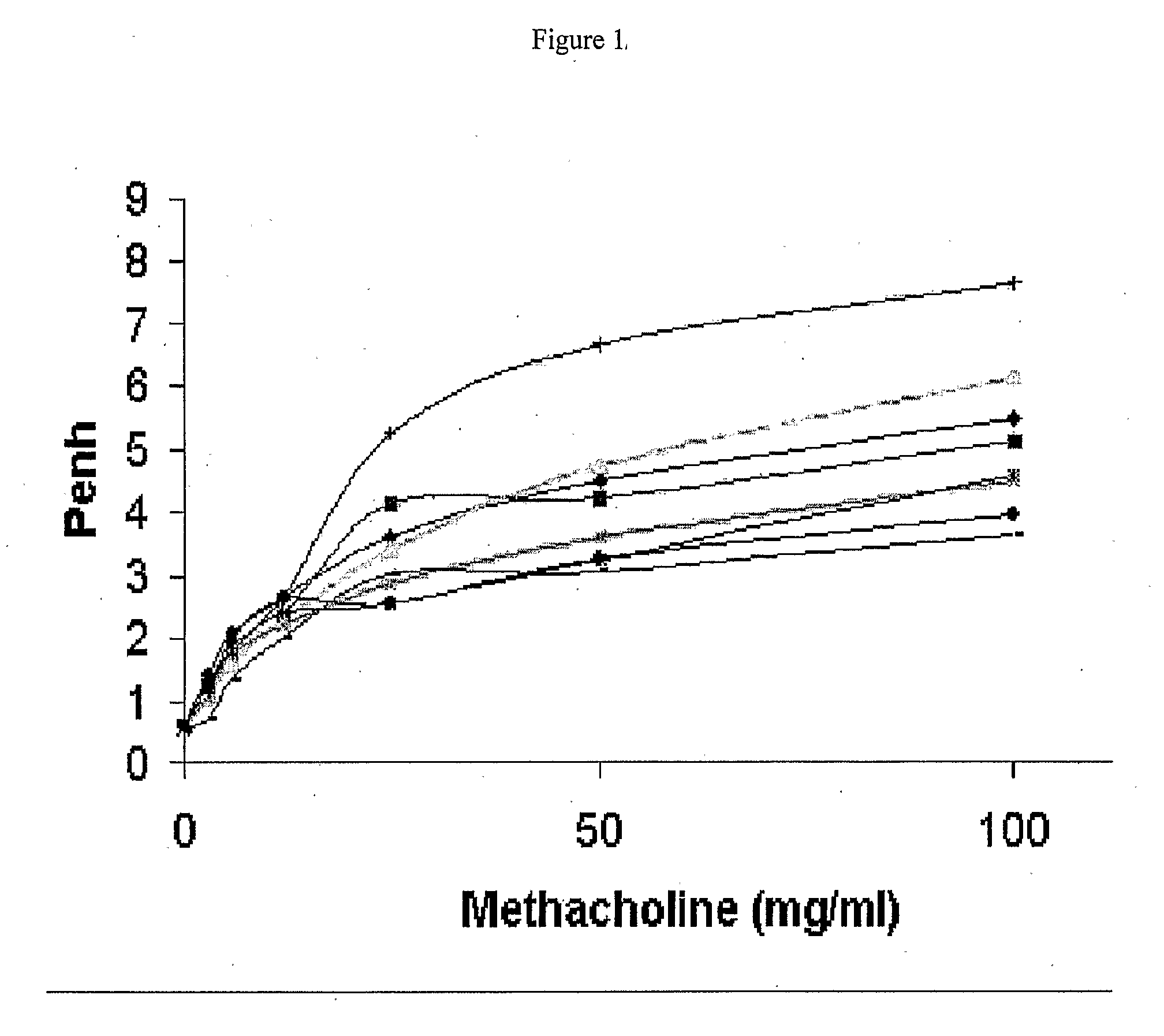Topical administrations of antisense compounds to vla-4 for the treatment of respiratory conditions
- Summary
- Abstract
- Description
- Claims
- Application Information
AI Technical Summary
Benefits of technology
Problems solved by technology
Method used
Image
Examples
example 1
In Vivo Study on Ability of Aerosol Administered ASOs to Reduce the Level of Integrin α4 Protein Expressed in Allergen Challenged Mice
[0136]Airway inflammation is observed in patients with allergic asthma. This study evaluated the efficacy of ISIS 348592 and ISIS 348574 in an in vivo murine model of allergic asthma. Models of ovalbumin-induced lung inflammation and airway hyperreactivity (AHR) are described in the prior art. For example, they are described in U.S. Pat. No. 6,136,603, the entire contents of which is incorporated herein by reference. A preferred model is that developed by Hessel et al. (J. Immunol. 1998, 160, 2998-3005). Sensitization of BALB / c mice with ovalbumin induces a high level of ovalbumin-specific IgE in serum. Inhalation of ovalbumin in sensitized mice causes an immediate bronchoconstrictive response. Repeated inhalation of ovalbumin in sensitized animals induces nonspecific airway hyperresponsiveness in vivo, and infiltration of leukocytes in airway tissue....
example 2
In Vivo Study on Ability of Aerosol Administered ASOs to Reduce the Number of Pas-Positive Airways in Allergen Challenged Mice
[0151]This study evaluated the ability of ISIS 348574 to reduce the level of mucus produced in an in vivo murine model of allergic asthma and compared it with an 8 mismatch control ASO ISIS 358342. The level of mucus was assessed through staining with periodic acid-schiff (PAS) reagent.
[0152]Mice were sensitised, challenged and treated with ASOs exactly as described in study 1. The treatment groups were as follows:
GroupTreatment (ASO)Dose (μg / kg body weight)1ISIS 3485740.012ISIS 34857413ISIS 3485741004ISIS 3583420.015ISIS 35834216ISIS 3583421007Vehicle8Naive
[0153]There were 15 animals in each treatment group. There were two control groups, one receiving the aerosol vehicle alone (Group 7) the other control group being a naive control (Group 8). At day 27, five animals in each group underwent FACS. At day 28, the remaining 10 animals in each group where sacrif...
example 3
In Vivo Study on the Target-Mediated Pharmacological Activity of an Aerosol Administered ASO in a Mouse Model of Asthma
[0156]E-cadherin positive cells are epithelial cells of which about 25% are mucuc-producing goblet cells. This study evaluated the ability of ISIS 348574 to target integrin α4 production in E-cadherin positive cells and compared it with the 8 mismatch (MM) control ASO ISIS 358342.
[0157]Mice were sensitised, challenged and treated with ASOs exactly as described in study 1. The treatment groups were as follows:
GroupTreatmentDose (μg / kg body weight)1ISIS 348574 (ASO)0.012ISIS 348574 (ASO)13ISIS 358342 (MM)0.014ISIS 358342 (MM)15Vehicle6Naive
[0158]There were 15 animals in each treatment group. There were two control groups, one receiving the aerosol vehicle alone (Group 5) the other control group being a naive control (Group 6). At day 27, five animals in each group underwent FACS. At day 28, the remaining 10 animals in each group where sacrificed. Lungs were recovered ...
PUM
| Property | Measurement | Unit |
|---|---|---|
| Dimensionless property | aaaaa | aaaaa |
| Dimensionless property | aaaaa | aaaaa |
| Dimensionless property | aaaaa | aaaaa |
Abstract
Description
Claims
Application Information
 Login to View More
Login to View More - R&D
- Intellectual Property
- Life Sciences
- Materials
- Tech Scout
- Unparalleled Data Quality
- Higher Quality Content
- 60% Fewer Hallucinations
Browse by: Latest US Patents, China's latest patents, Technical Efficacy Thesaurus, Application Domain, Technology Topic, Popular Technical Reports.
© 2025 PatSnap. All rights reserved.Legal|Privacy policy|Modern Slavery Act Transparency Statement|Sitemap|About US| Contact US: help@patsnap.com



